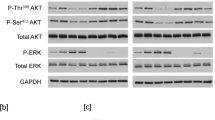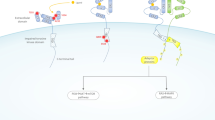Abstract
Breast cancers that overexpress the ERBB2 tyrosine kinase receptor may be treated with the recombinant humanized monoclonal anti-ERBB2 antibody trastuzumab (herceptin). However, resistance to this targeted therapy is frequent. We have determined the response of 18 breast tumor cell lines to trastuzumab and compared it with the ERBB2 phosphorylation status using antibodies directed against tyrosine residue 1248. We show that sensitivity to trastuzumab is frequently associated with the expression of a phosphorylated ERBB2 protein.
This is a preview of subscription content, access via your institution
Access options
Subscribe to this journal
Receive 50 print issues and online access
$259.00 per year
only $5.18 per issue
Buy this article
- Purchase on Springer Link
- Instant access to full article PDF
Prices may be subject to local taxes which are calculated during checkout



Similar content being viewed by others
References
Adélaïde J, Huang HE, Murati A, Alsop AE, Orsetti B, Mozziconacci MJ et al. (2003). A recurrent chromosome translocation breakpoint in breast and pancreatic cancer cell lines targets the neuregulin/NRG1 gene. Genes Chromosomes Cancer 37: 333–345.
Anastasi S, Sala G, Huiping C, Caprini E, Russo G, Iacovelli S et al. (2005). Loss of RALT/MIG-6 expression in ERBB2-amplified breast carcinomas enhances ErbB-2 oncogenic potency and favors resistance to Herceptin. Oncogene 24: 4540–4548.
Badache A, Hess D, Dankort D, Muller WJ, Hynes NE, Badache A . (2004). Memo mediates ErbB2-driven cell motility. Nat Cell Biol 6: 515–522.
Baselga J, Carbonell X, Castaneda-Soto NJ, Clemens M, Green M, Harvey V et al. (2005). Phase II study of efficacy, safety, and pharmacokinetics of trastuzumab monotherapy administered on a 3-weekly schedule. J Clin Oncol 23: 2162–2171.
Baselga J, Gianni I, Geyer C, Perez EA, Riva A, Jackisch C . (2004). Future options with trastuzumab for primary systemic and adjuvant therapy. Semin Oncol 31: 51–57.
Bernard-Marty C, Lebrun F, Awada A, Piccart MJ . (2006). Monoclonal antibody-based targeted therapy in breast cancer: current status and future directions. Drugs 66: 1577–1591.
Bertucci F, Borie N, Ginestier C, Groulet A, Charafe-Jauffret E, Adélaïde J et al. (2004). Identification and validation of an ERBB2 gene expression signature in breast cancers. Oncogene 23: 2564–2575.
Borg JP, Marchetto S, Le Bivic A, Ollendorff V, Jaulin-Bastard F, Saito H et al. (2000). ERBIN: a basolateral PDZ protein that interacts with the mammalian ERBB2/HER2 receptor. Nat Cell Biol 2: 407–414.
Charafe-Jauffret E, Ginestier C, Monville F, Finetti P, Adélaïde J, Cervera N et al. (2006). Gene expression profiling of breast cell lines identifies potential new basal markers. Oncogene 25: 2273–2284.
Cho HS, Mason K, Ramyar KX, Stanley AM, Gabelli SB, Denney Jr DW et al. (2003). Structure of the extracellular region of HER2 alone and in complex with the Herceptin Fab. Nature 421: 756–760.
Cobleigh MA, Vogel CL, Tripathy D, Robert NJ, Scholl S, Fehrenbacher L et al. (1999). Multinational study of the efficacy and safety of humanized anti-HER2 monoclonal antibody in women who have HER2-overexpressing metastatic breast cancer that has progressed after chemotherapy for metastatic disease. J Clin Oncol 17: 2639–2648.
Diermeier S, Horvath G, Knuechel-Clarke R, Hofstaedter F, Szollosi J, Brockhoff G . (2005). Epidermal growth factor receptor coexpression modulates susceptibility to Herceptin in HER2/neu overexpressing breast cancer cells via specific erbB-receptor interaction and activation. Exp Cell Res 304: 604–619.
Emens LA . (2005). Trastuzumab: targeted therapy for the management of HER-2/neu-overexpressing metastatic breast cancer. Am J Ther 12: 243–253.
Ethier SP, Mahacek ML, Gullick WJ, Frank TS, Weber BL . (1993). Differential isolation of normal luminal mammary epithelial cells and breast cancer cells from primary and metastatic sites using selective media. Cancer Res 53: 627–635.
Ghatak S, Misra S, Toole BP . (2005). Hyaluronan constitutively regulates ErbB2 phosphorylation and signaling complex formation in carcinoma cells. J Biol Chem 280: 8875–8883.
Gonzalez-Angulo AM, Hortobagyi GN, Esteva FJ . (2006). Adjuvant therapy with trastuzumab for HER-2/neu-positive breast cancer. Oncologist 11: 857–867.
Hudelist G, Kostler WJ, Czerwenka K, Kubista E, Attems J, Muller R et al. (2006). Her-2/neu and EGFR tyrosine kinase activation predict the efficacy of trastuzumab-based therapy in patients with metastatic breast cancer. Int J Cancer 118: 1126–1134.
Kauraniemi P, Hautaniemi S, Autio R, Astola J, Monni O, Elkahloun A et al. (2004). Effects of Herceptin treatment on global gene expression patterns in HER2-amplified and nonamplified breast cancer cell lines. Oncogene 23: 1010–1013.
Konecny GE, Pegram MD, Venkatesan N, Finn R, Yang G, Rahmeh M et al. (2006). Activity of the dual kinase inhibitor lapatinib (GW572016) against HER-2-overexpressing and trastuzumab-treated breast cancer cells. Cancer Res 66: 1630–1639.
Lacroix M, Leclercq G . (2004). Relevance of breast cancer cell lines as models for breast tumours: an update. Breast Cancer Res Treat 83: 249–289.
Lee JW, Soung YH, Seo SH, Kim SY, Park CH, Wang YP et al. (2006). Somatic mutations of ERBB2 kinase domain in gastric, colorectal, and breast carcinomas. Clin Cancer Res 12: 57–61.
Letessier A, Sircoulomb F, Ginestier C, Cervera N, Monville F, Gelsi-Boyer V et al. (2007). Frequency, prognosis impact and subtype association of 8p12, 8q24, 11q13, 12p13, 17q12 and 20q13 amplifications in breast cancers. BMC Cancer 6: 245.
Li YM, Pan Y, Wei Y, Cheng X, Zhou BP, Tan M et al. (2004). Upregulation of CXCR4 is essential for HER2-mediated tumor metastasis. Cancer Cell 6: 459–469.
Marty M, Cognetti F, Maraninchi D, Snyder R, Mauriac L, Tubiana-Hulin L et al. (2005). Randomized phase II trial of the efficacy and safety of trastuzumab combined with docetaxel in patients with human epidermal growth factor receptor 2-positive metastatic breast cancer administered as first-line treatment: the M77001 study group. J Clin Oncol 23: 4265–4274.
Mass RD, Press MF, Anderson S, Cobleigh MA, Vogel CL, Dybdal N et al. (2005). Evaluation of clinical outcomes according to HER2 detection by fluorescence in situ hybridization in women with metastatic breast cancer treated with trastuzumab. Clin Breast Cancer 6: 240–246.
Nagata Y, Lan KH, Zhou X, Tan M, Esteva FJ, Sahin AA et al. (2004). PTEN activation contributes to tumor inhibition by trastuzumab, and loss of PTEN predicts trastuzumab resistance in patients. Cancer Cell 6: 117–127.
Nagy P, Friedlander E, Tanner M, Kapanen AI, Carraway KL, Isola J et al. (2005). Decreased accessibility and lack of activation of ErbB2 in JIMT-1, a herceptin-resistant, MUC4-expressing breast cancer cell line. Cancer Res 65: 473–482.
Nahta R, Takahashi T, Ueno NT, Hung MC, Esteva FJ . (2004). P27(kip1) down-regulation is associated with trastuzumab resistance in breast cancer cells. Cancer Res 64: 3981–3986.
Nahta R, Yu D, Hung MC, Hortobagyi GN, Esteva FJ . (2006). Mechanisms of disease: understanding resistance to HER2-targeted therapy in human breast cancer. Nat Clin Pract Oncol 3: 269–280.
Neve RM, Chin K, Fridlyand J, Yeh J, Baehner FL, Fevr T et al. (2006). A collection of breast cancer cell lines for the study of functionally distinct cancer subtypes. Cancer Cell 10: 515–527.
Orsetti B, Nugoli M, Cervera N, Lasorsa L, Chuchana P, Ursule L et al. (2004). Genomic and expression profiling of chromosome 17 in breast cancer reveals complex patterns of alterations and novel candidate genes. Cancer Res 64: 6453–6460.
Pegram M, Slamon DJ . (1999). Combination therapy with trastuzumab (Herceptin) and cisplatin for chemoresistant metastatic breast cancer: evidence for receptor-enhanced chemosensitivity. Semin Oncol 26: 89–95.
Piccart-Gebhart MJ, Procter M, Leyland-Jones B, Goldhirsch A, Untch M, Smith I et al. (2005). Trastuzumab after adjuvant chemotherapy in HER2-positive breast cancer. N Engl J Med 353: 1659–1672.
Ramsauer VP, Carraway CA, Salas PJ, Carraway KL . (2003). Muc4/sialomucin complex, the intramembrane ErbB2 ligand, translocates ErbB2 to the apical surface in polarized epithelial cells. J Biol Chem 278: 30142–30147.
Romond EH, Perez EA, Bryant J, Suman VJ, Geyer Jr CE, Davidson NE et al. (2005). Trastuzumab plus adjuvant chemotherapy for operable HER2-positive breast cancer. N Engl J Med 353: 1673–1684.
Tan-Chiu E, Yothers G, Romond E, Geyer Jr CE, Ewer M, Keefe D et al. (2005). Assessment of cardiac dysfunction in a randomized trial comparing doxorubicin and cyclophosphamide followed by paclitaxel, with or without trastuzumab as adjuvant therapy in node-positive, human epidermal growth factor receptor 2-overexpressing breast cancer: NSABP B-31. J. Clin Oncol 23: 7811–7819.
Vogel CL, Cobleigh MA, Tripathy D, Gutheil JC, Harris LN, Fehrenbacher L et al. (2002). Efficacy and safety of trastuzumab as a single agent in first-line treatment of HER2-overexpressing metastatic breast cancer. J Clin Oncol 20: 719–726.
Vogel CL, Cobleigh MA, Tripathy D, Gutheil JC, Harris LN, Fehrenbacher L et al. (2001). First-line Herceptin monotherapy in metastatic breast cancer. Oncology 61 (Suppl 2): 37–42.
Wobus M, Kuns R, Wolf C, Horn LC, Kohler U, Sheyn I et al. (2001). CD44 mediates constitutive type I receptor signaling in cervical carcinoma cells. Gynecol Oncol 83: 227–234.
Acknowledgements
We thank O Segatto for the gift of the MCF7/ERBB2 cell line, S Ethier for the gift of the SUM cell lines and JM Durey for help with the illustrations. This work was supported by Inserm, Institut Paoli-Calmettes, Ligue Nationale Contre le Cancer (Label DB) and Institut National du Cancer (ACI2004-2006, PHRC24-04).
Author information
Authors and Affiliations
Corresponding author
Additional information
Supplementary Information accompanies the paper on the Oncogene website (http://www.nature.com/onc).
Supplementary information
Rights and permissions
About this article
Cite this article
Ginestier, C., Adélaïde, J., Gonçalvès, A. et al. ERBB2 phosphorylation and trastuzumab sensitivity of breast cancer cell lines. Oncogene 26, 7163–7169 (2007). https://doi.org/10.1038/sj.onc.1210528
Received:
Revised:
Accepted:
Published:
Issue Date:
DOI: https://doi.org/10.1038/sj.onc.1210528
Keywords
This article is cited by
-
Modular cytokine receptor-targeting chimeras for targeted degradation of cell surface and extracellular proteins
Nature Biotechnology (2023)
-
Activity of trastuzumab emtansine (T-DM1) in 3D cell culture
Breast Cancer Research and Treatment (2021)
-
Regulation of dual specificity phosphatases in breast cancer during initial treatment with Herceptin: a Boolean model analysis
BMC Systems Biology (2018)
-
Nucleolin and ErbB2 inhibition reduces tumorigenicity of ErbB2-positive breast cancer
Cell Death & Disease (2018)
-
Targeting HER2 Positive Breast Cancer with Chemopreventive Agents
Current Pharmacology Reports (2015)



